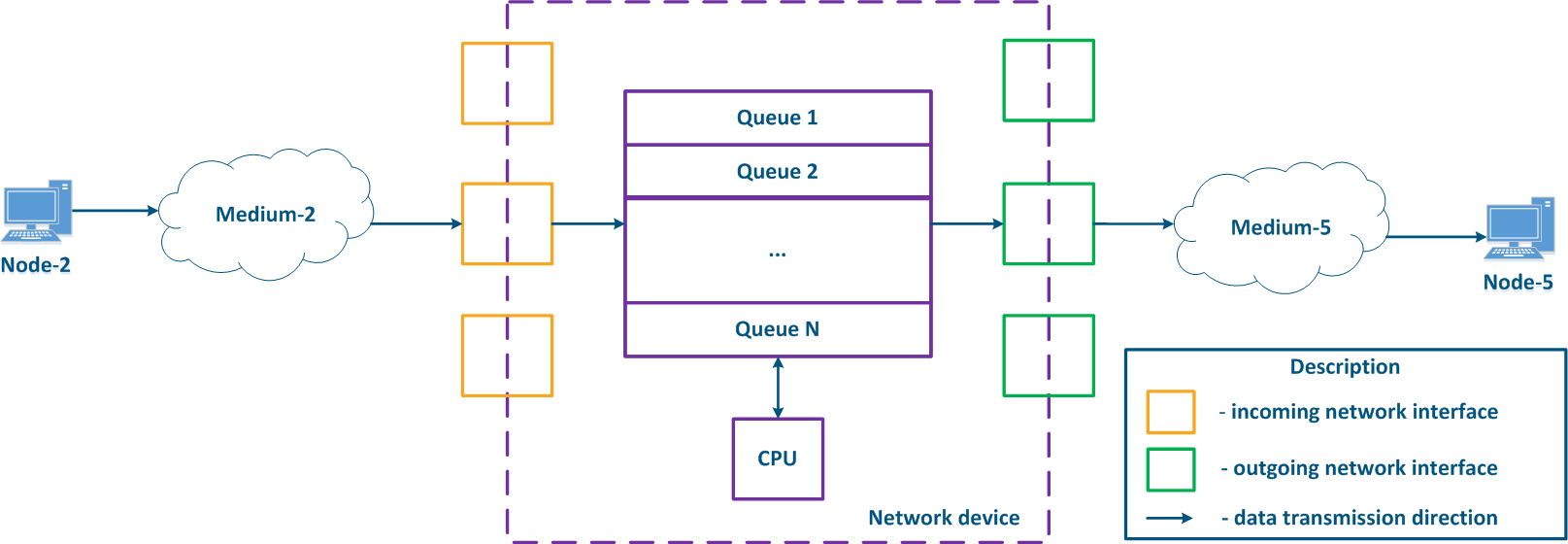...
| Anchor | ||||
|---|---|---|---|---|
|
In packet networks, the traffic is transmitted from the sending node to the receiving node through communication channels and intermediate devices. Generally a data packet is processed by each intermediate device independently. Let's look at the an example of a data packet processing performed by an intermediate network device (Figure 1):
- Node-2 forms a data packet and transmits it to Medium-2. The data packet is encapsulated in a frame based on the L2-protocol frame that is used in Medium-2.
- The data frame is distributed in Medium-2. The frame is converted into a modulated signal in accordance with an environment according to the physical properties of the environment. Signals The signals used in wired and wireless environments are different, which so this affects their propagation properties and their usage scenarios.
- The signal arrives at the input device interfaceincoming network interface of the intermediate network device; after demodulation, the received data frame is checked for integrity: the damaged frames are discarded.
- The next stage - routing determines frames further Next, the frame must be processed by the switching module in order to determine its path. If the frame is addressed to a Network this intermediate network device, it is will be passed for processing to the internal services. If the frame is addressed to another node, two scenarios are possible: the frame must be is passed to further through processing until it reaches the output interface, or it is discarded (if Medium-2 is a common environment, where all signals will be received by all devices connected to the medium. In accordance with , according to the L2 protocols protocol's operational principles, if the receiver destination address in the frame's header does not belong to the device, then the device should discard it).
- In case that the frame should be processed and transferred to another node, it enters the packets before exiting the device it will be placed into a packet queue. A packets packet queue is a set of buffers that contain the data received by the incoming interfaces. The number and size of the memory buffers for the packets packet queue storage are not standardized and depend on the equipment's manufacturer. For example, the InfiLINK 2x2 family of devices family has 32 queues, 17 of which are available for configuration by to the user.
- The data frame passes through the packets packet queue to which it was placed, assigned and enters arrives at the outgoing interface.
- Since packets packet queues are a link between incoming and outgoing interfaces, a device should have a controller that fills the queues with the incoming data and picks data from the queues for transmission to the outgoing interfaces. Usually, these functions are performed by the central processing unit (CPU). As it will be shown below, the filling and picking the emptying of data into and from the queues can be performed unevenly and depend depends on the classification of the data streams classification.
- The outgoing interface generates a modulated signal and transmits it to Medium-5 with which is connected to Node-5, which is the receiver destination of the original data frame.
- Node-5 receives a the signal, demodulates it, and processes the received data frame.
Note , that in the modern network devices, the network interfaces mostly are usually combined and can operate both as incoming and outgoing.
| Center |
|---|
Figure 1 - A Traffic passing through an intermediate network device traffic passing scheme |
A network device can be intermediate for several pairs of nodes, and each can transmit data of several services (Figure 2a). Let's look at the scheme there the Network device is intermediate for the traffic of nodes pairs Node-1 - Node-4, Node-2 - Node-5 and Node-3 - Node-6. The first pair transmits data of three services, the second of two, the third of one. If there are no QoS settings, the data of all services get through the general queue in the order they are received on the Network device and in the same order they will be transferred from the queue to outgoing interfaces.
...
